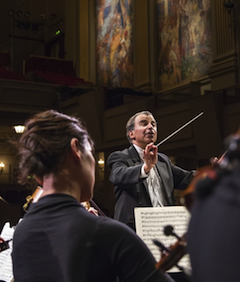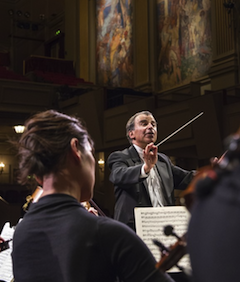
The San Francisco Chamber Orchestra threw a cheery French party over the weekend to open its 2012–2013 season. The well-planned, playful festivities of “La Belle France,” complete with costume pieces, double-reed heroics, and a little musical smuggling, got under way Friday at the First Congregational Church in Berkeley. The company did it all over again Saturday at the Herbst Theatre in San Francisco and Sunday at Stanford’s Dinkelspiel Auditorium.
A choice and certifiably French pairing of selections from François Couperin’s Les Goût réunis and Maurice Ravel’s Le Tombeau de Couperin was the major programming draw. The ensemble decanted its finest, most elegant, and shimmeringly translucent elixir in the Couperin. The concert offered other diverse, if less sustaining, pleasures.
Jauntiness and rhythmic wit ran steadily through Jean Françaix’s Divertissement for Bassoon and String Orchestra, with principal Karla Ekholm as the hard-working and good-natured soloist. Principal oboist Peter Lemberg was admirably fluent in the Ravel. And on the general principle that Mozart is always a welcome party guest, you had to hand it to Music Director Benjamin Simon for sneaking the Symphony No. 31 in D Major, K. 297, into the proceedings under the guise of its geographic origins and familiar title of “Paris.”
Simon was a genial host throughout, whether he was spinning around from his conductor’s post between Mozart movements to encourage the audience to applaud whenever they felt like it, or flashing a pair of bright red-and-white socks, or engaging in a bilingual conversation with principal bass player Michel Taddei. With Taddei donning a beret and reading his lines in French, Simon translated the musician’s account of living in Lyon and meeting Françaix (who died in 1997) at some classy maison.
OK, that bit was a little corny. But no one was inclined to complain. This concert, in keeping with the San Francisco Chamber Orchestra’s policy, was admission-free. A good-size and gratefully responsive crowd turned out in Berkeley.
Jauntiness and rhythmic wit ran steadily through Jean Françaix’s Divertissement for Bassoon and String Orchestra.
The First Congregational Church’s echoey acoustics posed some problems in the Mozart 31st at the top of the program. The woodwinds tended to disappear, while the timpani were all too present and accounted for. Yet the strings produced a sweet, lambent sound and played with admirable focus, clean intonation, and unity of purpose. That virtue prevailed for most of the night.
After some charm-free phrasing early on, the orchestra launched into the development section of Mozart’s opening Allegro with spirit and an air of fresh exploration. The movement’s ascending “Mannheim Rocket” scale shot up forcefully on its return flight. Simon opened up the lovely Andantino with limber tempos. The final Allegro had its brittle moments, but brought this Parisian episode to a lively conclusion.
Ready-made to Please
In its four short movements, only one of them lightly tinted with emotional shadows, Françaix’s 1968 Divertissement waves its stylish, ingratiating, and altogether French provenance like a flag. Its lightly jazzy feel evokes Milhaud. The blend of order and both rhythmic and harmonic tilts have a touch of Poulenc.
Right from the start, with an infectious riff from the soloist, this Divertissement sets out to divert and please. There’s lots of chatter between ensemble and soloist, including some amusing mimicry and teasing mockery. The bassoon’s occasional squawks are answered in kind. The soloist, fittingly, gets the quizzical last word.
Following the Couperin with Ravel’s affecting and colorful tribute to his predecessor was a canny notion.
Ekholm, who performed standing up, looked and sounded like she was having fun. She sold the perky themes and twirling embellishments with light-fingered conviction, tossing off Françaix’s sometimes lengthy chromatic sentences and cleverly italicizing their syncopations with accents and elastic timing. She was especially on point in the eventful third movement. But Ekholm never generated enough sound in the big space. While Simon did his best to hold the orchestral sound in check, the overall result was smaller and thinner than it might have been.
The concert reached its clear, if all too brief, high point right after intermission. In a suite of four Couperin pieces arranged by Fernand Oubradous, the orchestra found sure footing and took off. Everything came together in this sublime music, a consolidation of the Italian and French Baroque — the title Les Goût réunis means “Styles Reunited” — that Couperin supposedly offered as a lift for the depressed Louis VIV.
The strings served as the supporting mesh, woven carefully but loosely enough to allow the other colors to shine through. Trumpeters Owen Miyoshi and James Dooley sent up their sweet, singing tones. The woodwinds, to a one, were graceful, demure, and assertive in just the right measure. Violins, violas, cellos, and basses found and maintained their own internal balances. Simon was at his best. And the acoustical challenges melted away.
Following the Couperin with Ravel’s affecting and colorful tribute to his predecessor was a canny notion. Unfortunately, after a silvery Prélude distinguished by Lemberg’s adroit oboe work, the performance foundered. Ravel’s distinctive orchestration of his own piano work (four of the original six movements were translated) came across murkily. Details, from strings, woodwinds, and harp, failed to cohere. There were a few blunders. Tempos turned mushy. The admirable transparency of the Couperin went into hiding.
The most notable reprieve came in the quietly exotic middle section of the Rigaudon. Once again, the impressive woodwinds had a moment to sparkle. Couperin, in this interlude, was clearly summoned forth in his tombeau.

